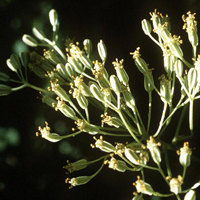Tuberous Indian-plantain
Scientific name: Arnoglossum plantagineum

Cover photo credit: Milo Pyne
Status
Special Concern
“Special Concern” means the species lives in the wild in Ontario, is not endangered or threatened, but may become threatened or endangered due to a combination of biological characteristics and identified threats.
Date added to the Species at Risk in Ontario List
The Tuberous Indian-plantain was already assessed as a species of special concern when the Endangered Species Act took effect in 2008.
What it looks like
The Tuberous Indian-plantain is a perennial plant in the aster family. It grows as a flat rosette of leaves that hug the ground, but in spring sends up a tall flower stalk that can reach 1.8 metres in height. The stalk produces a flat-topped cluster of 30 to 100 white flowers that bloom from June to August.
Where it lives
This species prefers open sunny areas in wet, calcium-rich meadows or shoreline fens. In Ontario, it grows along river banks and in wetlands near Lake Huron.
Where it’s been found in Ontario
In the United States, the range of the Tuberous Indian-plantain extends from Ohio and Michigan west to South Dakota, south to Texas and Alabama and east to the Appalachians. In Canada, it only grows in southern Ontario, where it is believed to still occur at about 18 sites near Lake Huron, most of them on the west side of the Bruce Peninsula.
View a larger version of this map (PDF)
What threatens it
The main threats to this species in Ontario are the mowing of wet meadows for hay, trampling by livestock along riverbanks, draining of wetlands for cottage and shoreline development, and impacts of recreational activities.
Action we are taking
Special concern species do not receive species or habitat protection.
What you can do
Report a Sighting
- Report a sighting of an endangered animal or plant to the Natural Heritage Information Centre. Photographs with specific locations or mapping coordinates are always helpful.
Volunteer
- Volunteer with your local nature club or provincial park to participate in surveys or stewardship work focused on species at risk.
Be a good steward
- Private land owners have a very important role to play in species recovery. You may be eligible for stewardship programs that support the protection and recovery of species at risk and their habitats.
Report illegal activity
- Report any illegal activity related to plants and wildlife to 1-877-TIPS-MNR (847-7667).
Quick facts
- The Tuberous Indian-plantain reproduces from seeds that are dispersed by the wind. Wind dispersal is aided by a "parachute" of hairs on top of each seed, which allow the seeds to travel greater distances.
- "Tuberous" refers to the plant’s fleshy, thickened roots.
